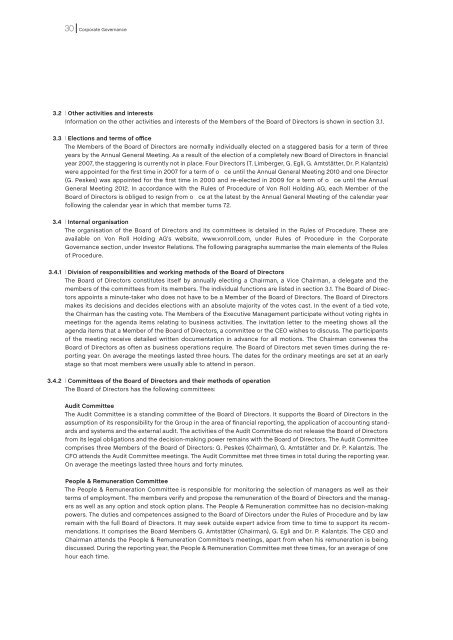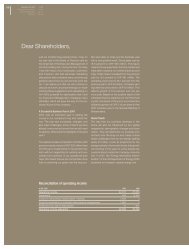Annual Report 2009 - Von Roll
Annual Report 2009 - Von Roll
Annual Report 2009 - Von Roll
- No tags were found...
You also want an ePaper? Increase the reach of your titles
YUMPU automatically turns print PDFs into web optimized ePapers that Google loves.
30 Corporate Governance3.23.33.43.4.13.4.2| Other activities and interestsInformation on the other activities and interests of the Members of the Board of Directors is shown in section 3.1.| Elections and terms of officeThe Members of the Board of Directors are normally individually elected on a staggered basis for a term of threeyears by the <strong>Annual</strong> General Meeting. As a result of the election of a completely new Board of Directors in financialyear 2007, the staggering is currently not in place. Four Directors (T. Limberger, G. Egli, G. Amtstätter, Dr. P. Kalantzis)were appointed for the first time in 2007 for a term of office until the <strong>Annual</strong> General Meeting 2010 and one Director(G. Peskes) was appointed for the first time in 2000 and re-elected in <strong>2009</strong> for a term of office until the <strong>Annual</strong>General Meeting 2012. In accordance with the Rules of Procedure of <strong>Von</strong> <strong>Roll</strong> Holding AG, each Member of theBoard of Directors is obliged to resign from office at the latest by the <strong>Annual</strong> General Meeting of the calendar yearfollowing the calendar year in which that member turns 72.| Internal organisationThe organisation of the Board of Directors and its committees is detailed in the Rules of Procedure. These areavailable on <strong>Von</strong> <strong>Roll</strong> Holding AG’s website, www.vonroll.com, under Rules of Procedure in the CorporateGovernance section, under Investor Relations. The following paragraphs summarise the main elements of the Rulesof Procedure.| Division of responsibilities and working methods of the Board of DirectorsThe Board of Directors constitutes itself by annually electing a Chairman, a Vice Chairman, a delegate and themembers of the committees from its members. The individual functions are listed in section 3.1. The Board of Directorsappoints a minute-taker who does not have to be a Member of the Board of Directors. The Board of Directorsmakes its decisions and decides elections with an absolute majority of the votes cast. In the event of a tied vote,the Chairman has the casting vote. The Members of the Executive Management participate without voting rights inmeetings for the agenda items relating to business activities. The invitation letter to the meeting shows all theagenda items that a Member of the Board of Directors, a committee or the CEO wishes to discuss. The participantsof the meeting receive detailed written documentation in advance for all motions. The Chairman convenes theBoard of Directors as often as business operations require. The Board of Directors met seven times during the reportingyear. On average the meetings lasted three hours. The dates for the ordinary meetings are set at an earlystage so that most members were usually able to attend in person.| Committees of the Board of Directors and their methods of operationThe Board of Directors has the following committees:Audit CommitteeThe Audit Committee is a standing committee of the Board of Directors. It supports the Board of Directors in theassumption of its responsibility for the Group in the area of financial reporting, the application of accounting standardsand systems and the external audit. The activities of the Audit Committee do not release the Board of Directorsfrom its legal obligations and the decision-making power remains with the Board of Directors. The Audit Committeecomprises three Members of the Board of Directors: G. Peskes (Chairman), G. Amtstätter and Dr. P. Kalantzis. TheCFO attends the Audit Committee meetings. The Audit Committee met three times in total during the reporting year.On average the meetings lasted three hours and forty minutes.People & Remuneration CommitteeThe People & Remuneration Committee is responsible for monitoring the selection of managers as well as theirterms of employment. The members verify and propose the remuneration of the Board of Directors and the managersas well as any option and stock option plans. The People & Remuneration committee has no decision-makingpowers. The duties and competences assigned to the Board of Directors under the Rules of Procedure and by lawremain with the full Board of Directors. It may seek outside expert advice from time to time to support its recommendations.It comprises the Board Members G. Amtstätter (Chairman), G. Egli and Dr. P. Kalantzis. The CEO andChairman attends the People & Remuneration Committee’s meetings, apart from when his remuneration is beingdiscussed. During the reporting year, the People & Remuneration Committee met three times, for an average of onehour each time.

















